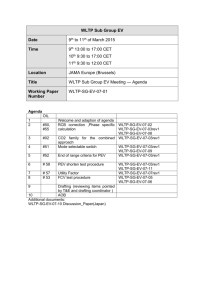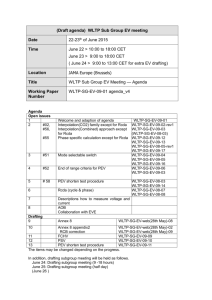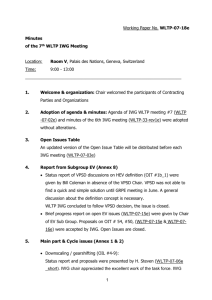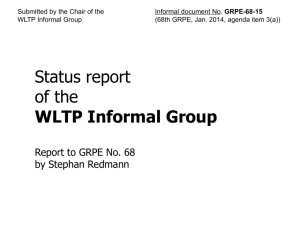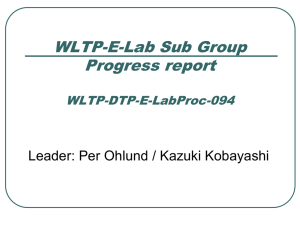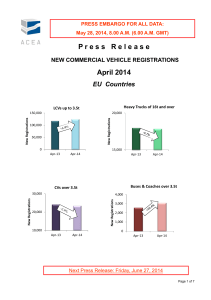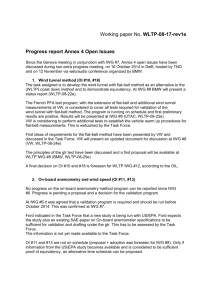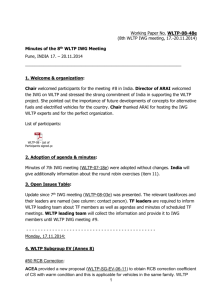WLTP-SG-EV-04-13 minutes
advertisement
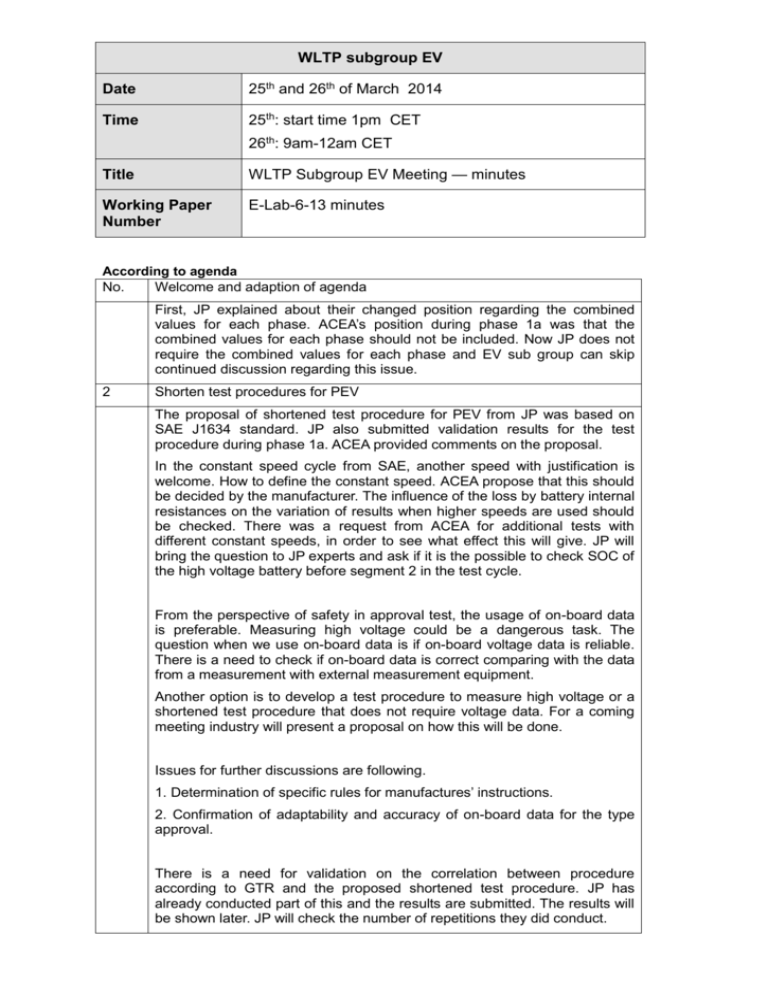
WLTP subgroup EV Date 25th and 26th of March 2014 Time 25th: start time 1pm CET 26th: 9am-12am CET Title WLTP Subgroup EV Meeting — minutes Working Paper Number E-Lab-6-13 minutes According to agenda No. Welcome and adaption of agenda First, JP explained about their changed position regarding the combined values for each phase. ACEA’s position during phase 1a was that the combined values for each phase should not be included. Now JP does not require the combined values for each phase and EV sub group can skip continued discussion regarding this issue. 2 Shorten test procedures for PEV The proposal of shortened test procedure for PEV from JP was based on SAE J1634 standard. JP also submitted validation results for the test procedure during phase 1a. ACEA provided comments on the proposal. In the constant speed cycle from SAE, another speed with justification is welcome. How to define the constant speed. ACEA propose that this should be decided by the manufacturer. The influence of the loss by battery internal resistances on the variation of results when higher speeds are used should be checked. There was a request from ACEA for additional tests with different constant speeds, in order to see what effect this will give. JP will bring the question to JP experts and ask if it is the possible to check SOC of the high voltage battery before segment 2 in the test cycle. From the perspective of safety in approval test, the usage of on-board data is preferable. Measuring high voltage could be a dangerous task. The question when we use on-board data is if on-board voltage data is reliable. There is a need to check if on-board data is correct comparing with the data from a measurement with external measurement equipment. Another option is to develop a test procedure to measure high voltage or a shortened test procedure that does not require voltage data. For a coming meeting industry will present a proposal on how this will be done. Issues for further discussions are following. 1. Determination of specific rules for manufactures’ instructions. 2. Confirmation of adaptability and accuracy of on-board data for the type approval. There is a need for validation on the correlation between procedure according to GTR and the proposed shortened test procedure. JP has already conducted part of this and the results are submitted. The results will be shown later. JP will check the number of repetitions they did conduct. There is a need for additional validation tests. EC can accept to introduce the procedure if it is up to CP needs. JP will check if this can be accepted as a way forward. Otherwise there will be necessary with more validation data. There was a question regarding the reason why additional L and M phase in the test cycle for shortened procedure is necessary. JP answered that the extra L and M are only to make balanced distance between cycles. ACEA will consider to conduct validation test to see if WLTPcity is also applicable when shorten test is adopted. 3 Phase specific calculation method formula for OVCHEV The original JP proposal is only applicable to vehicles with at least one complete CD cycle. ACEA asked about the case of vehicles with only the transition cycle. There is no appropriate solution for this case at the moment. With this method there should be a correction of RCB for each phase in the CS test even when no correction is necessary for whole cycle, this is currently not in the GTR. JP accepts that this method gives values with low accuracy. Nevertheless, JP persists in a position to provide a large number of values, such as FC, in order for vehicle users to compare their driving behavior. ACEA questioned the necessity of such large number of FC values. JP means that this is a calculation approach and no need for a validation. But there might be of interest to test different types of OVC-HEV to see how the proposed calculation method works. For example vehicles with only a transition cycle in the CD test. JP will take the response back to the JP EV group for further discussion and present the conclusion on a coming meeting. 4a, 4b CO2 family definition and combined approach JP proposal was about the definition of CO2 family and use of the combined approach for OVC-HEV and NOVC-HEV. Under the following (1) to (3) conditions, basically the combined approach for CS test is applicable. (1) same specification of battery/inverter/motor (2) SOC correction factor need to be developed for both points (3) Rcdc shall be same for OVC-HEV ACEA questions about the necessity of this large number of values for CO2, FC and ranges. ACEA also pointed that it is wrong to interpolate for each phase because each phase specific values will be influenced by SOC variations (see section 3 above). JP will bring the concern regarding each phase specific values to JP EV group and return with feedback on coming meeting. We should not finalize CO2 family definition before the combined approach development is finalized. That means that we need to change the road map regarding CO2 family definition to be in line with combined approach, which means final proposal to WLTP IWG at the 10 meeting. JP proposal for family definition for PEV. ACEA position is to use the same family definition for PEV as for HEV. Also proposes to wait with the finalization until final proposal for combined approach will be presented to WLTP IWG. ACEA presentation will be circulated when agreed by ACEA members. Comment from T&E, there is no longer the expression of test mass L and test mass H on the present draft GTR. They are replaced vehicle L and vehicle H. 5a, 5b adaption of Annex 1, Section 7.3 to electrified vehicles Cycle modification, WLTCcity only for lower maximum speed EV subgroup has started to discuss the power determination for HEV and PEV. One alternative is to keep the current GTR text and not use the down scale method for EV. ACEA will bring a proposal for determination of power within four weeks. The presentation of final proposal to WLTP IWG will be postponed to meeting 8. 6 Utility Factor We had a presentation from ACEA EV group about UF. ACEA EV group analyzed two databases, WLTP for EU and Fiat Ecodrive database. EU has decided to use a UF curve based on WLTP EU and FIAT databases as the EU UF. Since there are not large number of OVC-HEV on the market the determination of UF is a prediction, and only possible to use individual option. The UF needs to be reviewed later when the number of vehicles are larger. Proposal for UF determination in phase 1b GTR is based on SAE J2841. Based on regional driving data, with method to derive the curve described in the GTR according to SAE J2841. The final proposal for determination of UF according to the ACEA EV group proposal will be presented to WLTP IWG on the 9th meeting. What is valid input data for revision of regional UF determination? Needs to be specified in the regional implementation of WLTP GTR. EV subgroup has made a decision to refer SAE J2841 to develop regional UF in each region while accepting the currently available UF in US and JPN. 7 HEV definition EC submitted a problem description of the current HEV definition in the GTR. In order to clarify and to avoid the misunderstanding for type approval of for example range extender hybrid vehicles, EU regulation has already been amended, but EC not confident that the amended EU regulation solves the problem. The proposed definition in the document solves this issue. The proposal from T&E, based on proposal from EC, was accepted as preliminary definition of HEV from EV subgroup. If requested from stakeholders proposal for another definition can be presented on the next EV subgroup meeting. Also agree that the issue will be raised in VPSD to do a general overview of the HEV definition. Proposal: Hybrid Electric Vehicle (HEV) means a vehicle that can draw energy from both of the following on-vehicle sources, a) a consumable fuel b) a REESS and uses this energy directly, or indirectly through one or more energy converters for the purpose of vehicle propulsion. 8 AOB Editorial changes based on comments from the GTR drafting coordinator. In section 2.1 REESS preparation, the word “shall” replaced by “should”. In this case “shall” will be used. Regarding Eac, should it be removed or not. The expression is used and the text should be amended to “recharge energy from the grid”. Regarding definition of CD break of criteria, this is clearly defined in the annex and can be removed in the definition part. The EV subgroup will do a general overview of the definitions in annex 8 and if there are definitions that are not used they will be removed from the GTR.
